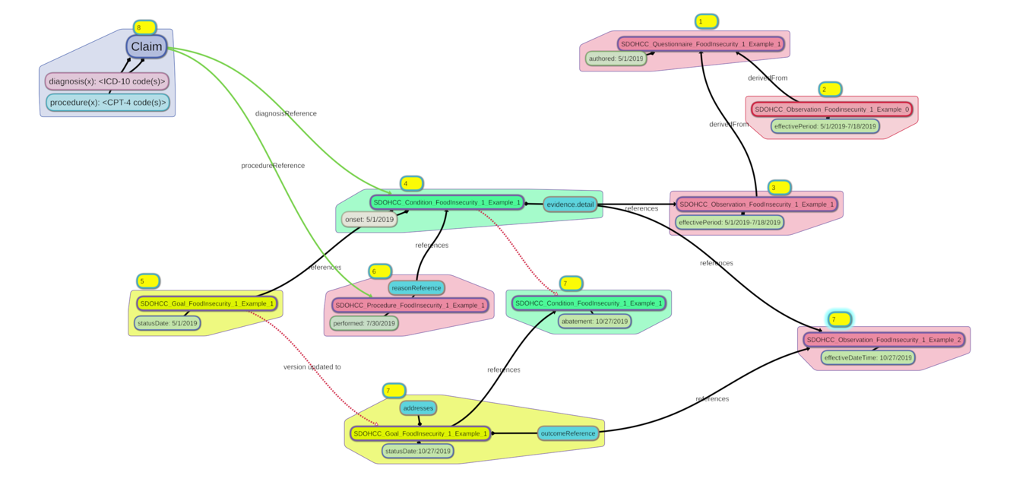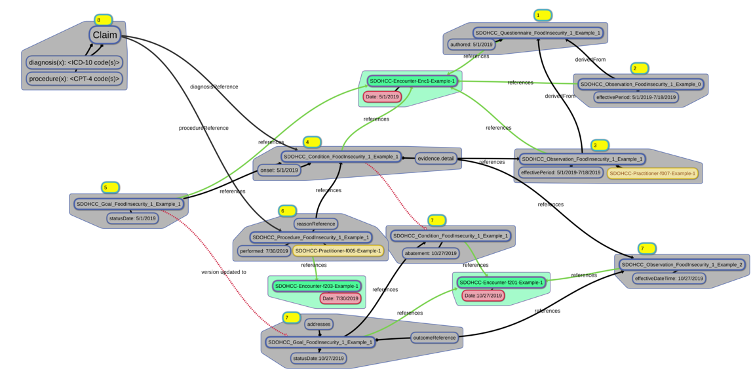SDOH Clinical Care - Local Development build (v0.0.4C3). See the Directory of published versions
About SDOH-CC Food Insecurity Standardized Data Exchange Examples
Previous Page - About SDOH-CC IdentifierSystem Temporary Identifiers
This IG defines a collection of profiles for representing screening information for food insecurity and documenting clinical data related to food insecurity which a clinician would record during a patient visit. It also defines profiles that support making a referral for services to address food insecurity and supplying feedback about a completed referral. Recording and sharing coded SDOH information improves how data can be used.
The example demonstrates how the SDOH-CC profiles supports four common uses of coded data.
- Document Screening results digitally to allow them to be included in the patient’s electronic health record.
- Record SDOH Data in a way that aligns with the existing clinical data paradigm
- Share SDOH referral information to connect the clinical setting with community-based support services
- Gather SDOH information at the point of care and re-use the data to support quality measurement, research, and public or population health
- Align with financial models, support claims payment, and the accelerate the shift toward value-based care
###Example 1:
Initiate Screening SDOHCC-Questionnaire-HungerVitalSign-1-Example-1 is used as an instrument to assess food insecurity.
Patient is screened for food insecurity prior to appointment. Screening information is available to clinician at point care to support clinical assessment of the patient’s conditions.
- SDOHCC-QuestionnaireResponse-HungerVitalSign-1-Example-1 is used to hold the patient’s responses to the Questionnaire screening instrument.
- SDOHCC_Observation_Foodinsecurity_1_Example_0 (STILL IN DEVELOPMENT) is a computed observation based on QuestionnaireResponse.
Patient is seen in the office, 5/1/2019, and reports food insecurity that began about a month ago.
- SDOHCC_Observation_FoodInsecurity_1_Example_1 is created.
- SDOHCC_Condition_FoodInsecurity_1_Example_1 is created, and references SDOHCC_Observation_FoodInsecurity_1_Example_1.
- SDOHCC_Goal_FoodInsecurity_1_Example_1 is created, and references SDOHCC_Condition_FoodInsecurity_1_Example_1.
An intervention for social service assistance is requested.
Patient is seen by social services, 7/30/2019
- SDOHCC_Procedure_FoodInsecurity_1_Example_1 is performed, and references SDOHCC_Condition_FoodInsecurity_1_Example_1.
Patient is seen back in the office, 10/27/2019, and reports resolution of food insecurity.
- SDOHCC_Observation_FoodInsecurity_1_Example_2 is created, documenting absence of food insecurity.
SDOHCC_Condition_FoodInsecurity_1_Example_1 is updated to reflect that condition is now in remission, and adds a reference to SDOHCC_Observation_FoodInsecurity_1_Example_2.
SDOHCC_Goal_FoodInsecurity_1_Example_1 is updated to reflect that goal is achieved, and adds a reference to SDOHCC_Observation_FoodInsecurity_1_Example_2.
<table><tr><td> </td></tr></table>
</td></tr></table>
Share SDOH referral information to connect the clinical setting with community-based support services
STILL IN DEVELOPMENT
- SDOHCC_ServiceRequest_FoodInsecurity_1_Example_1
STILL IN DEVELOPMENT
Gather SDOH information at the point of care and re-use the data to support quality measurement, research, and public or population health
STILL IN DEVELOPMENT
- Mind Map about eCQM
Align with financial models, support claims payment, and the accelerate the shift toward value-based care
STILL IN DEVELOPMENT
- Mind Map about Claims
Example 2:
The diagram below illustrates the same scenario from the perspective of three different encounter dates. It illustrates the capture of data provenance for the procedures performed on 7/30/2019, [date #2] and [date #3].
 </td></tr></table>
</td></tr></table>